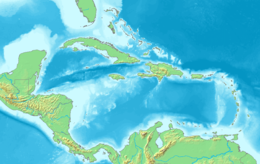Nickname: Love City | |
|---|---|
 Trunk Bay, Saint John, U.S. Virgin Islands | |
 Satellite image of Saint John | |
| Geography | |
| Location | Caribbean Sea |
| Coordinates | 18°20′N 64°44′W / 18.333°N 64.733°W |
| Archipelago | Virgin Islands, Leeward Islands |
| Area | 20[1] sq mi (52 km2) |
| Administration | |
| Insular area | |
| District | Saint John |
| Largest settlement | Cruz Bay (pop. 2,706) |
| Administrator | Shikima Jones[2] |
| Demographics | |
| Population | 3,881 (2020 census[3]) |
| Pop. density | 74.6/km2 (193.2/sq mi) |


Saint John (Danish: Sankt Jan; Spanish: San Juan) is one of the Virgin Islands in the Caribbean Sea and a constituent district of the United States Virgin Islands (USVI), an unincorporated territory of the United States.
Saint John (50 km2 (19 sq mi)) is the smallest of the three main US Virgin Islands.[4] It is located about four miles east of Saint Thomas, the location of the territory's capital, Charlotte Amalie. It is also four miles southwest of Tortola, part of the British Virgin Islands. Its largest settlement is Cruz Bay with a population of 2,652.[5] Saint John's nickname is Love City.[6]
Since 1956, approximately 60% of the island is protected as Virgin Islands National Park, administered by the United States National Park Service.[7] The economy is based predominantly on tourism and related trade.[8]
Saint John is 50.8 km2 (19.6 sq mi) in area with a population of 3,881 (2020 census).[5] As of the 2020 U.S. census, the population of the US Virgin Islands territory was 87,146,[5] comprising mostly persons of Afro-Caribbean descent.[9]
The US Virgin Islands is the only United States territory that drives on the left side of the road.
- ^ This is the figure given in the article at the on-line edition of the Encyclopedia Britannica. It is not the figure given by the government of the U.S. Virgin Islands on the St. John page of usvi.net, which reports the area to be 28 square miles. Other reliable sources report various figures closer to the Britannica figure. The Virgin Islands (United States) page at the United Nations Environment Programme's Island Directory gives the area as 50.0 square kilometers, equivalent to 19.3 square miles. A 1998 paper issued by the United States Geological Survey, Professional Paper 1631, reports the area as "about" 48 square kilometers, which is equivalent to 18.5 square miles (see page 1 of the paper). And although the U.S. Census Bureau does not report the areas of geographic entities, it does report their population densities (equal to the total population divided by the area). In the 2010 census, the population was reported as 4,170 (Table P1, "Total Population") and the population density was reported as 211.8 per square mile (Table P40, "Population Density"). Together, these figures imply an area of 19.7 square miles.
- ^ "Bryan Names Shikima Jones to St. John Administrator". St. John Source. February 5, 2019. Retrieved September 28, 2019.
- ^ "2020 Island Areas Censuses: U.S. Virgin Islands". US Census Bureau. Retrieved December 1, 2022.
- ^ "Where is the U.S. Virgin Islands: Geography". Virgin Islands.
- ^ a b c "2020 Island Areas Censuses: U.S. Virgin Islands (Table 1. Population of the United States Virgin Islands: 2010 and 2020)" (PDF). US Census Bureau. Retrieved December 1, 2022.
- ^ Jervis, Rick (September 3, 2018). "Hurricane recovery led by private groups on St. John one year later". USA Today. Retrieved May 17, 2019.
- ^ "Basic Information About Virgin Islands National Park". National Park Service. Retrieved August 14, 2018.
- ^ Austin, D. Andrew. "Economic and Fiscal Conditions in the U.S. Virgin Islands" (PDF). Congressional Research Service. Retrieved August 14, 2018 – via fas.org.
- ^ "Explore Census Data: 2020 DECIA U.S. Virgin Islands Demographic Profile". data.census.gov. Retrieved December 1, 2022.


